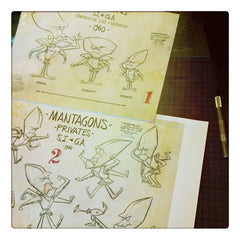What do Mickey Mouse, Spaceman Jax and “Carrie Ann” by The Hollies have in common?
Giclée prints.
By the time “Carrie Ann” hit radio stations in 1967, Spaceman Jax and the Galactic Adventures had been off the air for several years. And it would take nearly half a century more for the hit song from the British Invasion group The Hollies and our animated “hero with the heart of gold and the intellect of a Ploridian Lunar Beast” to significantly cross paths.
Though the classic animated series has yet to be released on DVD, we’ve been pleased to be able to bring you memorabilia from the show such as production drawings and model sheets – signed by character designer Philip La Carta no less! Those signed copies, a series of 1000, were giclée prints.
What the heck is a giclée print? Glad you asked.
A giclée is a high-quality, digitally-produced fine art print. The image is generated from high-resolution digital scans of the original and allows for the incredibly detailed prints seen in museums and galleries. A giclée provides better color accuracy than any other type of reproduction, and has all the tonalities and hues of the original work. Giclée printers are naturally much larger than a standard desktop printer. If you’ve ever seen a knitting machine, you’ll have a pretty good idea of the size.
The term giclée was coined in 1991 by Jack Duganne at Nash Editions to distinguish archival-quality prints from the utilitarian proofs being made by standard inkjet printers at the time. Nash Editions was at the forefront of digital printing, and is generally credited with inventing not just the term, but the process of giclée printing altogether. The original IRIS 3047 graphics printer used by Nash Editions now resides in the Smithsonian's National Museum of American History, along with one of its first published works – a 1969 portrait of David Crosby.
But here’s where the plot thickens.
Nash Editions was established by Graham Nash – founding member of The Hollies (“Bus Stop”, “On a Carousel”, and “Carrie Ann” of course, among others) as well as being the Nash in Crosby, Stills, Nash & Young (“Marrakesh Express”, “Teach Your Children”, “Our House” and more). Two-time inductee to the Rock and Roll Hall of Fame. That Graham Nash.
Nash was interested in photography as a child, and soon began taking his own photos (that photo of David Crosby in the Smithsonian – that’s by him). By the 1980s he had started to experiment with digital images of his photos on the computer, but soon found that he needed a printer capable of producing his detailed prints. David Coons, a color engineer for Disney at the time, helped Nash produce some of the images using the in-house IRIS printer at Disney Studios.
When Nash founded Nash Editions with Crosby, Stills, Nash & Young road manager Mac Holbert, David Coons joined them, along with fellow pioneers John Bilotta and Jack Duganne. They pushed the technology, designed their own printer heads and experimented with inks to bring us the very process that we use today to create limited edition prints of vintage ads from Bunchy or Oberpfaffendorfer, reproductions of Roger Believe comic book covers, and of course Spaceman Jax.
Isn’t it a small world?
